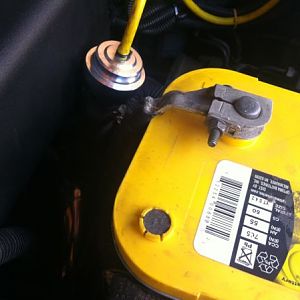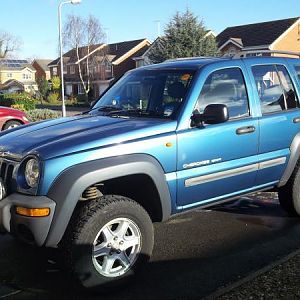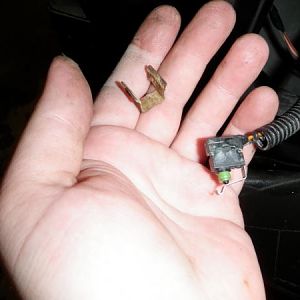Back story: After completely replacing *all* engine sensors, coils, injectors, and fabricating new independent harnesses for the coils and injectors, everything was running great and I put over 3000 miles on the Jeep, so I now know that dependable coil and injectors harnesses can be fabricated and deployed outside of the main wiring loom.
But a misfire recently happened again. This time it's happening on Cylinder #1, and it was originally only a problem with cylinder #4. The replaced harnesses had fixed #4 (over 3000 miles now and no recurrance), never had a problem with #1 until now. Weird.
So I went back into the engine compartment and looked over all of the connectors and wiring, in general. I believe that this rogue misfire may be due to the tangled nest of insulated wiring resulting from my 1st attempt at harness fabrication (coils and injectors) because I was lazy about trimming lengths for efficiency and it looks like I have a black octopus sleeping on the cyl 1/3/5 side of the top of my engine. Some wires are 12-18" too long and flop all over the place, and making contact with hot valve covers and the back/sides of the block itself.
I am going to build "version 2" of the coil and injector harnesses. In preparation I did a little deeper reading and found out that there are several artifacts in play that could trigger my mysterious misfire MIL, including:
1. Wires that are all tangled together can produce a phenomenon called "crosstalk" (akd "crossfire"). When a charge goes through a wire, the length of wire radiates a field of energy that can actually "jump" to another wire like some kind of ghost and simultaneously energizes that idle wire. There are 2 ways to avoid this:
1a. Keep all wires parallel to, and separated from, each other. Here's a good cable-tie-origami YT:
1b. If 2 wires must cross, they shoud cross as close to 90-degrees as possible. If you cannot manage 90-degrees, maintaining an airspace of at least 1 inch between the wires (cable-tie-origami separator) should work ok.
1c. This wire management effort is applicable to *all* sensor and fuel/ignition wires equally, because the PCM is constantly sampling inbound sensor signals and issuing outbound signals to the various mechanical components, engine *and* transmission. Signal interference of any kind, caused by crosstalk anywhere, can produce PCM misinterpretation and subsequent erroneous performance adjustments.
2. Exposing wires to engine heat is a problem.
2a. For my 1st harness rebuild I used TXL (thin-walled crosslinked) wire because of its heat resistance and because it is the most physically flexible of the 3 types of crosslink wires (TXL, SXL and GXL). The choice was arbitrary, but after the occasional resurface of rogue misfires I started to really dig down and review nuances of wire specs, and from what I have deduced,... and correct factory-spec is actually SXL (standard crosslink, which was referred to as "automotive primary wire" in one or two instances out of dozens of crosslink descriptions). It turns out that TXL has thin insulation covering, which implies the wires will run hotter (bad, but no as bad as Home Depot wire) and therefore be more jittery relative to signal/power transmission. Stable signal and power is key. Here is a good overview of the 3 types of crosslinked wires types: https://nassaunationalcable.com/blo..._0wZ3KsBVb0TluuAIoM3Ozo69CTsN4_cQVLSfZXAFtPc4 . I regularly see the notation "automotive primary wire" associated with SXL wire, so that is what I am rebuilding the harnesses with.
2b. Adding a wrap of 1/4" (or larger if bundling multiple wires) heat resistant sleeving helps to further reduce heat penetration and add crosstalk separation. See: https://www.amazon.com/MGI-SpeedWare-Split-Sleeve-Expandable-Overlap/dp/B07HXSL2SH?th=1 .
In summary, the recommended wiring best practice is to
A. Make sure all of your connectors are unbroken and lock onto coils and injectors firmly. Ditto for all sensors.
B. Implement good wire management, avoiding crosstalk risks, and keep all wires as short/direct as possible.
C. Wrap all wires with heat-resistant mesh and use high-temp electrical tape like Tesa 51036 (also replace any garbage hardware store electrical with Tesa).
I will follow up with results after the rebuild/install of harness(es) version 2.
But a misfire recently happened again. This time it's happening on Cylinder #1, and it was originally only a problem with cylinder #4. The replaced harnesses had fixed #4 (over 3000 miles now and no recurrance), never had a problem with #1 until now. Weird.
So I went back into the engine compartment and looked over all of the connectors and wiring, in general. I believe that this rogue misfire may be due to the tangled nest of insulated wiring resulting from my 1st attempt at harness fabrication (coils and injectors) because I was lazy about trimming lengths for efficiency and it looks like I have a black octopus sleeping on the cyl 1/3/5 side of the top of my engine. Some wires are 12-18" too long and flop all over the place, and making contact with hot valve covers and the back/sides of the block itself.
I am going to build "version 2" of the coil and injector harnesses. In preparation I did a little deeper reading and found out that there are several artifacts in play that could trigger my mysterious misfire MIL, including:
1. Wires that are all tangled together can produce a phenomenon called "crosstalk" (akd "crossfire"). When a charge goes through a wire, the length of wire radiates a field of energy that can actually "jump" to another wire like some kind of ghost and simultaneously energizes that idle wire. There are 2 ways to avoid this:
1a. Keep all wires parallel to, and separated from, each other. Here's a good cable-tie-origami YT:
xc_hide_links_from_guests_guests_error_hide_media
. I have not had another misfire since I rearranged the existing wiring so that everything is parallel, or widely separated by airspace.1b. If 2 wires must cross, they shoud cross as close to 90-degrees as possible. If you cannot manage 90-degrees, maintaining an airspace of at least 1 inch between the wires (cable-tie-origami separator) should work ok.
1c. This wire management effort is applicable to *all* sensor and fuel/ignition wires equally, because the PCM is constantly sampling inbound sensor signals and issuing outbound signals to the various mechanical components, engine *and* transmission. Signal interference of any kind, caused by crosstalk anywhere, can produce PCM misinterpretation and subsequent erroneous performance adjustments.
2. Exposing wires to engine heat is a problem.
2a. For my 1st harness rebuild I used TXL (thin-walled crosslinked) wire because of its heat resistance and because it is the most physically flexible of the 3 types of crosslink wires (TXL, SXL and GXL). The choice was arbitrary, but after the occasional resurface of rogue misfires I started to really dig down and review nuances of wire specs, and from what I have deduced,... and correct factory-spec is actually SXL (standard crosslink, which was referred to as "automotive primary wire" in one or two instances out of dozens of crosslink descriptions). It turns out that TXL has thin insulation covering, which implies the wires will run hotter (bad, but no as bad as Home Depot wire) and therefore be more jittery relative to signal/power transmission. Stable signal and power is key. Here is a good overview of the 3 types of crosslinked wires types: https://nassaunationalcable.com/blo..._0wZ3KsBVb0TluuAIoM3Ozo69CTsN4_cQVLSfZXAFtPc4 . I regularly see the notation "automotive primary wire" associated with SXL wire, so that is what I am rebuilding the harnesses with.
2b. Adding a wrap of 1/4" (or larger if bundling multiple wires) heat resistant sleeving helps to further reduce heat penetration and add crosstalk separation. See: https://www.amazon.com/MGI-SpeedWare-Split-Sleeve-Expandable-Overlap/dp/B07HXSL2SH?th=1 .
In summary, the recommended wiring best practice is to
A. Make sure all of your connectors are unbroken and lock onto coils and injectors firmly. Ditto for all sensors.
B. Implement good wire management, avoiding crosstalk risks, and keep all wires as short/direct as possible.
C. Wrap all wires with heat-resistant mesh and use high-temp electrical tape like Tesa 51036 (also replace any garbage hardware store electrical with Tesa).
I will follow up with results after the rebuild/install of harness(es) version 2.










